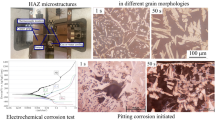Abstract
Annealed hypoeutectoid ASTM A510/A853 steel wire is widely used in the construction industry due to its mechanical properties, which makes it a very versatile material to work with. This work concerns the prediction of the thickness of the scale layer of the hypoeutectoid steel wire once subjected to a batch annealing process. We propose a mathematical model to approach oxidation occurring during the process. The model treats this phenomenon as a non-isothermic instance; it takes as input a heating curve, a cooling curve, and a holding time that corresponds to the heating and cooling cycles and a heating holding cycle. We assume the temperature of material outer spiral segments as the furnace atmosphere temperature. With the aid of this model, it is possible to predict the oxide scale layer of the outer spirals segments of the annealed drawn wire coils after batch annealing with reasonable accuracy. We did not find visible evidence of decarburization; the steels of the study in this work do not decarburize. As an approximation, we assumed that the temperature of the outside of the drawn wire coils equals the furnace atmosphere.




Similar content being viewed by others
References
ASTM A510/A510M - 11. standard specification for general requirements for wire rods and coarse round wire, carbon steel, and alloy steel. Standard, American Society for Testing and Materials, Pennsylvania, USA (January 2011).
ASTM A853 - 04 (Reapproved 2010). Standard specification for steel wire, carbon, for general use. Standard, American Society for Testing and Materials, Philadelphia, USA (April 2010).
Sae j403 dec2009. chemical compositions of sae carbon steels. Standard, Society of Automotive Engineers, USA (dec 2009).
A. H. Committee et al. Asm handbook volume 4 heat treating. ASM Standards, American Society for Metals, Materials Park, OH (1991).
J. Dossett, G. Totten, ASM Handbook, Volume 4A: Steel Heat Treating Fundamentals and Processes, ASM Intern. Ohio (2013).
R. E. Smallman, R. J. Bishop, Modern Physical Metallurgy and Materials Engineering, 6th Ed. Butterworth Heinemann, Kent, UK (1999).
A. K. Sinha, Physical Metallurgy Handbook. McGraw-Hill Professional Publishing, (2003).
W. D. Callister, D. G. Rethwisch, Materials Science and Engineering An Introduction. Wiley, Hoboken, NJ (2010).
L. Suarez, R. Coto, X. Vanden Eynde, M. Lamberigts, Y. Houbaert, High temperature oxidation of ultra-low-carbon steel. In: Defect and Diffusion Forum, vol. 258, pp. 158–163 (2006). Trans Tech Publ.
H.T. Abuluwefa, R. I. L. Guthrie, F. Ajersch, Oxidation of low carbon steel in multicomponent gases: Part ii. reaction mechanisms during reheating. Metallurgical and Materials Transactions A 28A, 1643–1652 (199y).
M. Kutz, Handbook of Environmental Degradation of Materials. William Andrew, (2018).
M. Zorc, A. Nagode, J. Burja, B. Kosec, B. Zorc, Metals 8(6), 425 (2018).
B. C. De Cooman, J. G. Speer, Fundamentals of Steel Product Physical Metallurgy. AIST, Association for Iron & Steel Technology, (2011).
T. Réti, M. Gergely, P. Tardy, Materials science and technology 3, 365 (1987).
G. C. FISICOQUIMICA, Segunda edición en español. Editorial Addison–wesley iberoamericana, 618–627 (1987).
P. Atkins, J. De Paula, Atkins’ physical chemistry new york wh freman (2006).
J. A. Sánchez de León, A mathematical model for the prediction of the scale layer formation on astm a510/a853 cold-drawn hypoeutectoid steel wire after batch annealing. PhD thesis, Universidad Autónoma de Nuevo León (2021).
A. Kirsch, An Introduction to the Mathematical Theory of Inverse Problems vol. 120. Springer, (2011).
F. -X. Dupé, J. M. Fadili, J. -L. Starck, Linear inverse problems with various noise models and mixed regularizations. In: 1st InternationalWorkshop on New Computational Methods for Inverse Problems (2011).
P. Sebastiani, A Tutorial on Probability Theory. University of Massachusetts at Amherst, MA USA (2008).
J. Kaipio, E. Somersalo, Statistical and Computational Inverse Problems vol. 160. Springer, (2006).
D. P. Bertsekas, J. N. Tsitsiklis, Introduction to Probability. Massachusetts Institute of Technology, MA USA (2000).
J. Holman, Heat transfer, 10th editi. ed. Mc-GrawHill Higher education (2010).
Astm e415 - 17. standard test method for analysis of carbon and low-alloy steel by spark atomic emission spectrometry. Standard, American Society for Testing and Materials, Pennsylvania, USA (aug 2017).
J. A. S. de León, Alternative representation for binomials and multinomies and coefficient calculation. In: Mathematical Theorems-Boundary Value Problems and Approximations. IntechOpen, (2020).
Iso/iec 17025:2017. general requirements for the competence of testing and calibration laboratories. Standard, Institute of Electronics and Computer, Switzerland (nov 2017).
ASTM E3 - 11. standard guide for preparation of metallographic specimens. Standard, American Society for Testing and Materials, Philadelphia, USA (June 2017).
Astm e407 - 07. standard practice for microetching metals and alloys. Standard, American Society for Testing and Materials, Pennsylvania, USA (May 2007).
Author information
Authors and Affiliations
Corresponding author
Additional information
Publisher's Note
Springer Nature remains neutral with regard to jurisdictional claims in published maps and institutional affiliations.
Appendix A Model parameters summary
Appendix A Model parameters summary
In order to make use of this model, parameters needed for it were gathered mainly from the bibliography. This section summarizes the required parameters; Table 4 provides them next.
Note: Original values for \(k_0\) and Ea from [9] are 8.8x10\(^6\) and 140738 J/mol, respectively, for temperatures \(T<1173 \text {K}\) whose mathematical model is \(x[\mu m]=K \cdot \sqrt{t}\). These values were converted to be usable for the isothermal model \(x^2[mm]=K \cdot t\), on which our model is based.
Rights and permissions
About this article
Cite this article
de León, J.A.S., Alanís-López, L. A Mathematical Model for the Prediction of the Scale Layer Formation on ASTM A510/A853 Cold-Drawn Hypoeutectoid Steel Wire After Batch Annealing. Oxid Met 97, 539–558 (2022). https://doi.org/10.1007/s11085-022-10101-x
Received:
Revised:
Accepted:
Published:
Issue Date:
DOI: https://doi.org/10.1007/s11085-022-10101-x




